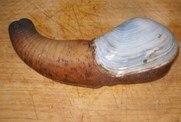Three weeks off work has allowed me to spend many a languid day in my sunny little garden, idly plucking plums and boysenberries, reading a good deal of trashy fiction, eating mountains of very good ( and largely unhealthy) food and indulging in long, delicious siestas. I never feel like summer has truly started until after Christmas, when the whole country (apart from those poor unfortunates stuck in the relentless drudgery of hard-core retail) falls into a lazy sort of stupor. The newspapers are full of pictures of babies at the beach and kittens found wanting, and there’s nothing to think about other than the next meal. For me this often means considering how and when to eat the various food items that turn up under the tree on Christmas morning. I’ve never been good at faking gratitude for socks and hanky’s, but thankfully it’s got to the point now where nobody bothers to give me anything that isn’t either edible or ovenproof. So my summer holidays are usually full of chocolates, cheese and various delectable preserved things. I must say though that I’m always disappointed by the lack, in fact complete absence of foie gras. Take note friends and family; I care nothing for your hippy-dippy goose-loving ethics.
I have one particular friend who takes a certain pleasure in finding obscure comestibles to slip into my stocking; last year she gave me a nice fat wedge of hard-to-find and fiendishly pricey Red-cow Parmigianino. This is a cheese with an uber-cool history and a flavour for which I’d gladly hunt babies. This year she surprised me with something altogether more original- a brace of alarmingly phallic Geoduck (which is inexplicably pronounced gooey duck and is neither gooey nor duck).
These giant molluscs are prized in many Asian cultures for their potent aphrodisiac “properties “and surprisingly delicate flavour. They are however almost unknown to the rest of the world, despite having been fished commercially in New Zealand (Golden Bay) for a number of years. I was a bit taken back by this gift. To describe Geoduck as phallic is like saying the Pope is a bit religious. They are more like giant, aquatic penises (penii?), complete with a horribly leathery “foreskin” and obscene squirting action. How anyone thought to eat them is beyond me; but then the dietary past of human kind is littered with perverse experimentation and dire depravity.
I have an aunt with a doctorate in Marine biology who once described eating Geoduck as akin to chewing on muddy leather, so knowing that and considering those castrator’s trophy looks ( the Geoduck, not my aunt) I was more than a little nervous. They weren’t even the kind of joke gift I could politely throw in the bin when I got home; they cost a not-so-small fortune and my friend (the giver) wanted the shells for her collection of bits of the beach. So I was stuck with a pair of free floating dangly bits with no idea how to cook them and a growing terror of having to eat them.
The Net is a wonderful thing when it comes to obscure foods. A few taps of the keyboard and you can learn how to cook anything- including Homo sapiens- and so it was that I found a step by step guide to preparing and eating Geoduck. Lucky me.
If first impressions were rough; getting up-close and intimate with Geoduck was positively traumatic.
The whole animal, shell and all, is dropped into boiling water, causing it to squeal horribly and squirt water from it’s… for want of a better word, urethra. They are then quickly plunged into cold water, which halts the cooking/torturing process. At about this point the “foreskin” is peeled away in one piece with a ghastly shucking noise, revealing a perfectly white sausage of seafood. This is pulled free from the shell and the distended, sludge filled gut; both of which- thank God- are discarded.
The remaining, not insubstantial slippery white wang is either eaten raw as sashimi or boiled until it almost melts into a sort of stew. The latter seemed like a sacrilege to visit upon any shellfish (however pornographic it may be) and there was no way I was going to eat raw, slimy sea-penis.
So I melted some butter, added a little garlic, sliced the meat thinly [rendering it quite inoffensive] and quickly sautéed it with a splash of Sauvignon blanc, a sprinkle of Italian parsley and some fresh chilli .
I thought it might make an ‘interesting’ (if nothing else) entrée to be followed by something reliably palatable, but my best beloved took one look at the great wobbly sausages and fled from the kitchen muttering (rather cruelly I thought) about the absurdity of boys’ bits. She stubbornly refused to return until all evidence and odour from aforementioned molluscs was gone. So it was just me and a somewhat daunting pile of Geoduck.
Actually it wasn’t too bad. You could even say it was nice I suppose. Firm but not chewy, with a flavour similar to cockles but perhaps a little sweeter. I would eat it again if someone else was paying and more importantly if someone else- preferably someone with a taste for Benny Hill inspired food- was doing the cooking. In my own kitchen I think I’ll just stick to cockles which taste pretty much the same, are much cheaper and bear no resemblance to human genitals.
Happy New Year







Nice article! Garlic and geoduck is a match made in heaven! Garlic and anything for that matter… or Geoduck and anything haha! I love them both!
I particularly like that last idea- sound ssimilar to octopus balls, which I love.
we have eaten geoduck on numerous occasions, both cooked and raw and if eaten fresh they are very scrumptious. don’t let the look of them put your off.
here is a few recipes you may wish to try:
#1….first clean and leave trunk.
blanch in boiling water for 4 seconds.
thinly slice and sprinkle with cracked pepper, then use soya and wasabi sauce or any sauce you prefer as a dipping sauce….
#2…..get handful of goeduck meat, garlic clove, ginger, spring onion, salt, pepper and pulse in a blender until it sticks to itself (no egg or flour needed)
make into small balls and deep fry.
A fantastic piece of writing, Virgil, reading your description was almost like being there! In fact, better than being there because the reader doesn’t have to have a ‘all 5-senses’ experience of the sea penis (unless, of course, they fancy giving one a go themselves).
As someone who finds oysters hard to stomach (I’m a heathen, I know), I might give the Geoduck a miss for now.
Sorry, Virgil! Having watched a clip on Youtube I retract the accusation of you being OTT. They are obscene.
I went and took a look at these this morning at the same fish shop. They had a huge number of them.
They were still alive, so I’d count that as pretty fresh. Glenys is a little biased [She gave them to me] but certainly knows her stuff, having written a number of books on things shellfishy. They came from the very good fish mongers under the rialto carpark in Newmarket.
Where oh where did your friend source these? And how fresh were they? I would be game to try them. Glenys has countered all that OTT suggestive squeamishness with interesting facts. Shame on you, Virgil! Thank you, Glenys. I think I might have had geoduck as difficult to identify sushi – more texture than taste?
My mind is completely closed on this one – no way I could cook or eat it.
One look at the photo had me shuddering before I read the text! :)
Mmmmmmm,
Men do have an obsession with their nether regions!Geoduck is from the native American Indian Gwe duc. The scientific name of the New Zealand species is Panopea (pronounced pan oh paya – nothing to do with a panoramic pee) zelandica. Like most filter feeding molluscs it has two tubes, an inhalent and an exhalent siphon as do pipi and tuatua. It just so happens that Panopea live quite deeply beneath the sand and unlike tuatua are rarely washed out. The two siphon tubes of Panopea are joined and never retracted(unlike pipi and tuatua). This double siphon tube is what is sliced and eaten. It lookes like con-joined squid rings and tastes, I think rather similar. Faced with having to remove the condom (skin)from one and the resultant exhalation of water in the process Virgil’s partner could be forgiven for having visions of Mrs Bobbitt.